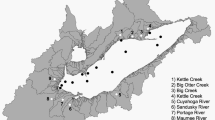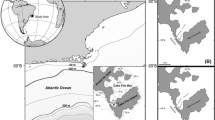Abstract
The chlorophyll content of seston at four sites in a regulated mid-order Rocky Mountain river, Henry's Fork of the Snake River, Idaho, USA, was examined. Spectrometry was used to determine the amount of chlorophyll a, b, c and in seston and potential organic matter sources including macrophytes, algae, plankton, and terrestial plant litter. The amount of chlorophyll in seston varied among size fractions, sites, and seasons. Coarse seston (6–1 mm) contained the most chlorophyll a (2.3 mg g−1 ashfree dry mass [AFDM]) followed by ultra fine seston (53–0.3 µm; 1.9 mg g−1 AFDM), very coarse seston (> 6 mm, 1.8 mg g−1 AFDM), very fine seston (250–53 µm; 1.3 mg g−1 AFDM), and fine seston (1–0.25 mm; 0.7 mg g−1 AFDM). Chlorophyll content of coarse seston was similar at all sites reflecting a common source, aquatic macrophyte debris. Chlorophyll content of coarse and fine seston were highest in fall reflecting the importance of phenology of aquatic plants on sestonic pigment levels. Very fine seston from below a reservoir contained more chlorophyll than seston from downstream and tributary sites suggesting a reservoir source. Terrestial plant litter was chlorophyll depleted compared to autochthonous materials and seston. Most seston was autochthonously-derived from a variety of macrophyte, algal, and planktonic sources. The chlorophyll content of Henry's Fork seston was higher than that reported for similar rivers. Island Park Dam moderates river temperature and flow, enhances autotrophy, and accounts for the consistently high sestonic chlorophyll levels.
Similar content being viewed by others
References
Angradi, T. R., 1991. Transport of coarse particulate organic matter in an Idaho River, USA. Hydrobiologia 211: 171–183.
APHA, 1989. Standard methods for the examination of water and wastewater. 17th edn. American Public Health Association, Washington D.C., USA.
Darley, W. M., 1977. Biochemical composition. In: D. Werner (ed.), The biology of diatoms. Blackwell Scientific, Oxford: 198–223.
Jeffrey, S. W. & G. F. Humphrey, 1975. New spectrophotometric equations for determining chlorophylls a, b, and c, in higher plants, algae, and natural phytoplankton. Biochem. Physiol. Pflanzen 167: 167–194.
Lorenzen, C. J., 1967. Determination of chlorophyll and pheopigments: spectrophotometric equations. Limnol. Oceanogr. 12: 343–346.
Meeks, J. C., 1974. Chlorophylls. In: W. D. P. Stewart (ed.), Algal physiology and biochemistry. Blackwell Scientific, Oxford: 161–175.
Naiman, R. J., 1983. The influence of stream size on the food quality of seston. Can. J. Zool. 61: 1995–2010.
Naiman, R. J. & J. R. Sedell, 1979. Benthic organic matter as a function of stream order in Oregon. Arch. Hydrobiol. 87: 404–422.
Naiman, R. J. & J. R. Sedell, 1979b. Characterization of particulate organic matter transported by some Cascade Mountain Streams. J. Fish. Res. Bd Can. 36: 17–31.
SPSS Inc., 1990. SPSS/PC+ Statistics 4.0 Manual. SPSS Inc. Chicago, Il.
USGS, 1989. Water resources data for Idaho. United States Geological Survey Water-Data Report ID-89: 91 pp.
Ward, G. M., 1986. Lignin and cellulose content of benthic fine particulate organic matter (FPOM) in Oregon Cascade Mountain streams. J. N. Am. Benthol. Soc. 5: 127–139.
Ward, J. V. & J. A. Stanford, 1983. The serial discontinuity concept of lotic ecosystems. In T. D. Fontaine, and S. M-.Bartell (eds), Dynamics of lotic ecosystems. Ann Arbor Science. Ann Arbor. MI: 29–42.
Wetzel, R. G. & G. E. Likens, 1991. Limnological methods. Springer-Verlag, New York, 391 pp.
Whitehead, R. L., 1978. Water resources of the upper Henry's Fork basin in eastern Idaho. Idaho Dep. Water Res. Info. Bull. 46.
Wood, A. M., 1979. Chlorophyll a:b ratios in marine planktonic algae. J. Phycol. 15: 330–332.
Author information
Authors and Affiliations
Rights and permissions
About this article
Cite this article
Angradi, T.R. Chlorophyll content of seston in a regulated Rocky Mountain river, Idaho, USA. Hydrobiologia 259, 39–46 (1993). https://doi.org/10.1007/BF00005963
Received:
Issue Date:
DOI: https://doi.org/10.1007/BF00005963




